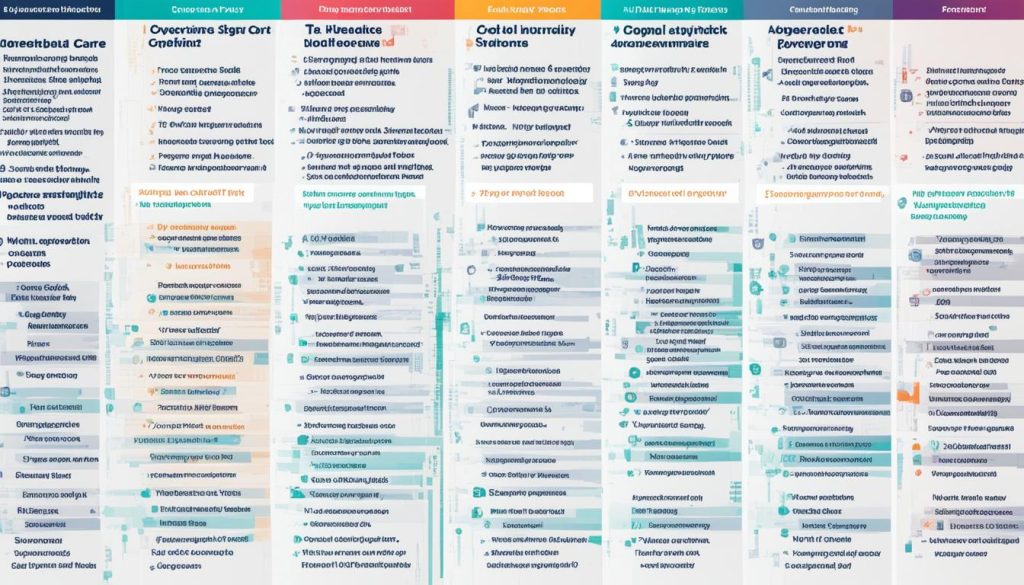Health insurance can seem complex, but picking the right plan is key for your health and wallet. Whether you’re looking for individual insurance, checking out employer options, or getting ready for Medicare, this guide will help. It will show you how to pick a plan that fits your needs and budget123.
This article will help you understand health insurance marketplaces and the various plan types. We’ll cover the importance of provider networks, out-of-pocket costs, and covered services. This will give you a clear view of what to think about when comparing plans23.
We’ll also look into Medicare’s unique features. This includes the differences between Original Medicare and Medicare Advantage Plans, and the perks of extra coverage. By the end, you’ll know how to pick the right coverage that matches your health needs and budget1.
Key Takeaways
- Learn about different health insurance plans like HMOs, PPOs, EPOs, and POS plans. See how they affect costs and provider choices.
- See why in-network and out-of-network providers matter, along with the network size, when picking a plan.
- Think about your health needs and budget to balance premiums, deductibles, copays, and coinsurance when looking at plans.
- Discover Medicare’s special features, including Original Medicare vs. Medicare Advantage Plans, and the perks of extra coverage.
- Check the services each plan covers, like physical therapy, mental health care, and emergency services.
Understanding Health Insurance Marketplaces
The Health Insurance Marketplace is a place where people and small businesses can look for health insurance plans. These marketplaces can be state or federal. They let you see different plans, compare them, and see if you can get subsidies or tax credits4.
If your job offers health insurance, you might not need the marketplace. But, you can still check those plans to find the best one4.
Employer-Sponsored Health Insurance
Many Americans get their health insurance from their jobs. Employers offer these plans as a benefit. They often cost less than plans bought on the marketplace.
State and Federal Health Insurance Exchanges
You can also buy health insurance through state or federal exchanges under the Affordable Care Act (ACA). These exchanges let individuals and families look for and sign up for private health plans. You might use your state’s exchange or the federal HealthCare.gov platform4.
The open enrollment for 2024 health coverage starts on November 1, 2023, and ends on January 16, 2024. Some states might have later deadlines4. You can enroll in Medicaid anytime and apply for marketplace coverage if you qualify4.
The Health Insurance Marketplace Calculator helps estimate 2024 premiums and subsidies. It looks at age, income, zip code, and family size to see if you’re eligible for subsidies or Medicaid4. It also talks about tax credits from the ARPA and new rules against surprise medical bills4.
The KFF lists nine key things to watch in the 2024 open enrollment. This includes a 5% rise in unsubsidized premiums and state policy changes4. State Health Facts Data offers more info on Marketplaces4.
The resources include FAQs in English and Spanish. They aim to help specific groups understand the health insurance Marketplaces from the ACA4.
Types of Health Insurance Plans
When looking for health insurance, you’ll see various plan types, each with unique features and costs. It’s key to know these options to pick the right coverage for your health needs and budget.
HMO (Health Maintenance Organization)
HMO plans are often the cheapest but come with some limits. You must use doctors within their network and get a referral to see specialists5. This approach can help manage your health better but limits your choice of doctors.
PPO (Preferred Provider Organization)
PPO plans let you see doctors in and out of network without a referral6. But, you’ll pay more for care outside the network. PPOs have a big network, so they’re great if you like choosing your own doctors.
EPO (Exclusive Provider Organization)
EPO plans mix HMO and PPO benefits. They’re cheaper than PPOs but you must use the plan’s doctors, except in emergencies6. EPOs are a good pick if you want to save money but still have some choice in doctors.
POS (Point of Service Plan)
POS plans combine HMO and PPO elements. You’ll need a primary care doctor and referrals for specialists6. But, you can see doctors outside the network for more cost. This is handy if you have a preferred doctor not in the network.
When looking at these plans, think about your health needs, who you want to see, and your budget576.

Evaluating Network Coverage
When picking a health insurance plan, knowing the difference between in-network and out-of-network providers is key. In-network providers work with your insurance to offer lower costs for you8. Out-of-network providers charge more because they don’t have these deals with insurance companies8. Picking a plan with many in-network providers in your area can cut down your healthcare costs.
In-Network vs. Out-of-Network Providers
The size and reach of a health plan’s provider network matter a lot. A big network means more choices for in-network care, which is great if you live in a rural area or have a favorite doctor8. It also means easier access to specialists and hospitals, giving you more control over your health care8.
| In-Network Providers | Out-of-Network Providers |
|---|---|
| Have pre-negotiated rates with the insurance company | Do not have negotiated rates with the insurance company |
| Lower out-of-pocket costs for you | Higher out-of-pocket costs for you |
| Typically include a wider range of healthcare providers and facilities | May have limited availability or not be available in your local area |
Importance of Network Size
The size and reach of a health plan’s provider network are key. A big network means more in-network care options, which is vital if you’re in a rural area or prefer a certain doctor8. It also means easier access to specialists and hospitals, giving you more control over your health care8.
“Using network provider search tools is key to check coverage for doctors and specialists. It’s also important to look at the plan’s drug list to see what’s covered.”8
Always take the time to review the provider network and services of any health insurance plan you’re looking at. This way, you can make a smart choice and get the care you need without spending too much8.
Coverage Options: Assessing Out-of-Pocket Costs
When picking a health insurance plan, think about your monthly premiums and out-of-pocket costs. These costs include your deductible, copays, and coinsurance. Knowing these can help you pick a plan that balances your monthly costs and healthcare expenses.
Deductibles, Copays, and Coinsurance
Your deductible is the first amount you pay before your insurance helps cover costs9. After you’ve paid your deductible, you’ll pay a set amount or a share of costs for each service9. Plans with higher monthly payments usually have lower deductibles and costs, while cheaper plans might have higher costs9.
Balancing Premiums and Out-of-Pocket Costs
Finding the right balance between your monthly premium and out-of-pocket costs is key. Plans with higher monthly payments often have lower costs, and vice versa9. Think about your healthcare needs and budget to pick the best plan for you9. Also, consider the plan’s out-of-pocket maximum, which is the most you’ll pay in a year for services9.
Looking at different plan types, like Bronze, Silver, Gold, and Platinum, helps you understand costs and premiums9. Plans with clear pricing and set costs make it easier to choose your coverage9.
“More than a quarter of all Medicare recipients spend about 20% of their annual income on out-of-pocket costs after Medicare reimbursements.”10
For Medicare users, knowing about deductibles, premiums, and maximum out-of-pocket costs is crucial10. This knowledge helps you make a smart choice and manage your healthcare costs well.
By looking at your out-of-pocket costs, you can find a health insurance plan that fits your needs and budget9. This careful review will help you make a wise choice and get the best value from your healthcare coverage.
Comparing Plan Benefits
When picking a health insurance plan, it’s key to look at what services are covered. This means more than just the monthly cost. You need to know the full range of benefits and limits in each plan11.
Scope of Services Covered
Health insurance plans differ a lot in what they cover. Some offer a wide range, including preventive care, hospital stays, emergency help, drug coverage, and special treatments. Others might cover less, making you pay more for healthcare11.
Make sure to check the summary of benefits for each plan. Look at deductibles, copays, and coinsurance. This will show you which plan fits your health needs and budget best11.
| Plan Type | Average Coverage of Medical Costs | Average Out-of-Pocket Costs |
|---|---|---|
| Platinum | 90% | 10% |
| Gold | 80% | 20% |
| Silver | 70% | 30% |
| Bronze | 60% | 40% |
| Catastrophic | First 3 primary care visits + preventive care for free | High deductible of $8,700 in 2022 |
The services covered affect the plan’s cost too. Plans with more benefits usually cost more. Those with fewer benefits might be cheaper but could cost more when you need care11.
Take your time to review and compare Health Insurance Benefits, Covered Services, and Scope of Coverage across plans. This way, you’ll find the best mix of cost and healthcare for you and your family11.

“The key to finding the right health insurance plan is understanding the full scope of services covered and how that aligns with your unique healthcare needs and budget.”
Medicare Coverage Options
When you think about healthcare in retirement, Medicare is key. You can get Medicare coverage through Original Medicare or Medicare Advantage plans12.
Original Medicare (Part A and Part B)
Original Medicare is the traditional plan run by the government. It has Part A for hospital stays and Part B for doctor visits. Part A covers things like hospital stays and skilled nursing care. Part B covers outpatient services and preventive care12. You can also get a separate plan for prescription drugs (Part D)12.
Medicare Advantage Plans (Part C)
Medicare Advantage, or Part C, is a private plan option. It covers everything Part A and Part B do, plus more like vision and dental care12. Most of these plans also cover prescription drugs (Part D)13. But, you’ll need to use doctors in the plan’s network and might need a referral for specialists. These plans can be cheaper than Original Medicare but might limit your doctor choices12.

Choosing between Original Medicare and Medicare Advantage depends on your healthcare needs and what you prefer. Think about the provider network, costs, and extra benefits. The best choice for you will be based on your health and personal choices.
“The right Medicare coverage can make a significant difference in your healthcare experience and financial well-being during retirement.”
Additional Considerations
When looking at healthcare options, think about a few key points to get the most from your coverage and keep costs down14.
Health Savings Accounts (HSAs)
Health Savings Accounts (HSAs) let you save and pay for medical costs with tax benefits. They go with high-deductible health plans (HDHPs), which have lower monthly costs but higher upfront costs. You put money into an HSA before paying taxes, and you can take money out without paying taxes for medical expenses14. HSAs are great for handling out-of-pocket costs and planning for future health needs.
Supplemental Coverage Options
With Original Medicare, Medigap or Medicare Supplement Insurance can cover costs like deductibles and copays15. These plans come from private companies and offer extra financial help. Retirees might also keep their employer health insurance, which can work with Original Medicare15. Looking into these options can help you find the best coverage for your health needs.
“HSAs can be a powerful tool for managing healthcare costs and planning for the future.”
Conclusion
Choosing the right health insurance can seem hard, but this guide has given you the tools to make a smart choice16. You now know about different health plans, how to check provider networks, and how to look at costs. This way, you can pick coverage that meets your health needs and fits your budget16.
The conclusion is key in tying the study’s findings back to the bigger picture17. It’s vital to talk about any unexpected results you found. This shows their importance and how they might lead to more research17.
When picking Choosing Health Insurance, Health Plan Comparison, and Making an Informed Decision, this guide has helped a lot18. It shows how health insurance helps you get more preventive care and a steady source of medical attention. This is especially true for groups like Hispanics and African Americans18. Make sure to look at each plan closely, compare them, and get advice if you need it. This way, you can find the best coverage for you and your family.
FAQ
What are the different types of health insurance plans?
There are several health insurance plans like HMOs, PPOs, EPOs, and POS plans. Each plan has its own set of features and costs. They also have different provider networks.
How do I evaluate a health insurance plan’s provider network?
It’s key to know the difference between in-network and out-of-network providers. Also, check the plan’s provider network size and coverage area. A plan with a big network can save you money on healthcare costs.
What factors should I consider when comparing out-of-pocket costs?
Look at deductibles, copays, coinsurance, and the out-of-pocket maximum when comparing plans. High-premium plans usually have lower out-of-pocket costs. But, low-premium plans might have higher costs for deductibles and other expenses.
How do I find the right balance between my monthly premium and out-of-pocket costs?
Think about your healthcare needs and budget to find the right balance. High-premium plans often have lower costs for deductibles and other expenses. But, low-premium plans might cost more out-of-pocket. Weigh the costs against your healthcare needs.
What should I look for when comparing the scope of services covered by different health plans?
Check the services covered, like preventive care, hospital stays, and prescription drugs. Make sure the plan covers the care you need. Look at the benefits summary for each plan carefully.
What are the main Medicare coverage options?
Medicare has Original Medicare and Medicare Advantage plans. Original Medicare covers things like hospital stays and preventive care. Medicare Advantage plans offer extra benefits like vision and dental care from private insurers.
How can Health Savings Accounts (HSAs) help with healthcare costs?
HSAs are savings accounts for medical expenses. They’re linked with high-deductible health plans. You can put pre-tax dollars in them and use the money for healthcare costs without paying taxes on it.
What are the supplemental coverage options for those with Original Medicare?
Medigap or Medicare Supplement Insurance can cover out-of-pocket costs with Original Medicare. Some retirees might also keep employer health insurance with Original Medicare.
Source Links
- Your Medicare coverage choices
- 8 steps to choosing a health insurance plan
- How to Choose Health Insurance: Your Step-by-Step Guide – NerdWallet
- Understanding the Health Insurance Marketplaces | KFF
- The health plan categories: Bronze, Silver, Gold & Platinum
- Types of Health Insurance Plans
- Types of Health Plans: How They Compare
- How to find out what your health insurance covers | HealthPartners Blog
- Your total costs for health care: Premium, deductible, and out-of-pocket costs
- Medicare Out-of-Pocket Maximums
- Compare medical plans | Washington State Health Care Authority
- Your coverage options
- Your health plan options
- Filling the Coverage Gap: Policy Options and Considerations | KFF
- Consider these 7 things when choosing coverage
- Essay Conclusions | UMGC
- Research Guides: Organizing Your Social Sciences Research Paper: 9. The Conclusion
- Effects of Health Insurance on Health – Care Without Coverage

